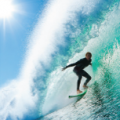Surf to Successful Teen Engagement
When thinking about how our kids recreate today, remember that you are talking to the X-Box/Playstation generation.
They are digitally integrated. And they have their own language and their own recreation needs. Those recreation needs are based on a voracious appetite for entertainment and sensory input, and are light years beyond the previous generations. As parents we often scoff at what we perceive as their addiction to the “virtual” world. In reality we likely tend to scoff at things or people we don’t fully understand. Our children’s recreation needs are changing, much as our society is changing as we integrate much more sensory stimuli and “virtual reality” into our lives.
The need for today’s children to absorb ever-greater levels of stimuli is evolving rapidly. This is particularly significant when considering the extremely important teenage demographic. Some will say that today’s teens lack the imagination of previous generations. Perhaps, but many suspect that their imagination is functioning like their brains are on steroids, fueled by the incredible sensory stimulus generated by videogames, movies, MTV and the Internet.
 Outdoor recreation is not immune to these changes, nor does the term “outdoor recreation” mean the same thing to teenagers today that it did to generations past. Understanding this evolving youth culture is becoming an increasingly difficult and critical task for business and educational facilities to absorb. Successfully implementing the changes necessary to remain relevant to today’s teens is becoming an imperative. Simply offering teens the same entertainment and activity venues that older generations had is simply inadequate for their needs. We’re leaving today’s teenagers’ sensory input needs fundamentally unfulfilled with traditional, “old school” park and recreation activities.
Outdoor recreation is not immune to these changes, nor does the term “outdoor recreation” mean the same thing to teenagers today that it did to generations past. Understanding this evolving youth culture is becoming an increasingly difficult and critical task for business and educational facilities to absorb. Successfully implementing the changes necessary to remain relevant to today’s teens is becoming an imperative. Simply offering teens the same entertainment and activity venues that older generations had is simply inadequate for their needs. We’re leaving today’s teenagers’ sensory input needs fundamentally unfulfilled with traditional, “old school” park and recreation activities.
Commercial amusement and waterparks are already adapting to the changes in our society by offering a wider variety of alternatives to their teenage patrons. Why shouldn’t municipal parks do the same? In order to keep municipal parks relevant to the entire family, the time has come to consider how to elevate the entertainment value of the services that are provided. In other words, how do parks and recreation centers make the activities they offer more relevant to today’s youth culture?
This issue of relevant activities is even more critical to municipal aquatic centers, as many are hopelessly outdated. The stand-alone rectangular pool with a slide and a diving board is insignificant to the entertainment needs of today’s teenagers. While recent additions to municipal aquatic centers like zero-depth play areas, lazy rivers and the like have improved the quality of entertainment for families in general, the teenage demographic is still left unfulfilled in many ways.
One solution to the quandary of how to attract more teens can be found in the board sport subset of what are known as the “gravity sports” (snowboarding, skateboarding, inline skating and surfing, etc.). Their impact is found in all aspects of our teenagers’ lives, from the clothes and sunglasses they wear to the types of backpacks they use to carry their books. The impact of these sports on teenage culture is astounding, and tapping into that culture can provide a simple solution to the teenage interest question for many municipal aquatic centers. For instance, consider one of the more interesting solutions to be introduced in the past 10 years or so—the sheet wave, surfing simulator.
 Surfing? In our town?
Surfing? In our town?
Yes. Surfing. Surfing is the fastest-growing board sport today. Consider this: Adding a sheet wave simulator to your existing aquatics facility is much simpler than one might think. The space requirement is relatively small, only about 40-feet by 50-feet for a large unit. The units themselves are completely self-contained. They can be manned and monitored by as few as two staff members. So, operationally we are not talking about adding significant size to existing operations (either in square footage requirements or in manpower). Where these devices really stand out is their ability to draw in teenagers. Increases in attendance at municipal aquatic facilities with surfing simulators have been documented at 20 percent to 30 percent.
Board sports such surfing and skateboarding are skill-based activities that challenge riders to develop new tricks to emulate others or to top their friends. By comparison, riding down a large slide is a thrill-based activity. No skill is required. The more a participant rides a thrill-based ride, the less thrilling it becomes. Because surfing is a skill-based activity, surfing simulators tend to drive more repeat attendance and a large spectator element. This spectator draw tends to foster the social nature of the activity and further meshes with teenagers’ need for entertainment and social interaction. The end result is a significant increase in participation. When competition events are added to the programming mix, the social network developed tends to feed on itself, driving sustained attendance as teenagers commit to the sport to improve their skill.
 By adding a surfing simulator and thus driving up attendance among teenagers, an aquatic center can also enjoy the benefit of several new revenue streams. For example, it is generally accepted that most aquatic centers will charge a small up-charge to use the surfing simulator for daily body-boarding. In addition, centers can up-charge for many other types of activities that involve the surfing simulator, like stand-up riding fees, lessons for stand-up riding and party/event rentals. When managed properly, a surfing simulator can generate the revenue to cover its own expense in addition to driving other incremental revenue streams.
By adding a surfing simulator and thus driving up attendance among teenagers, an aquatic center can also enjoy the benefit of several new revenue streams. For example, it is generally accepted that most aquatic centers will charge a small up-charge to use the surfing simulator for daily body-boarding. In addition, centers can up-charge for many other types of activities that involve the surfing simulator, like stand-up riding fees, lessons for stand-up riding and party/event rentals. When managed properly, a surfing simulator can generate the revenue to cover its own expense in addition to driving other incremental revenue streams.
Most importantly, the addition of surfing and other teen-friendly amenities can greatly enhance the value and excitement of any municipal aquatics facility and add true multigenerational programming with minimal impact on current operations.




.png)








Leave a Reply